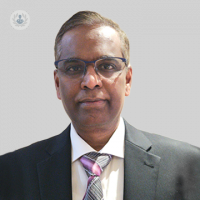How quickly does heart failure progress?
Escrito por:Heart failure is a chronic condition that occurs when the heart is unable to pump oxygen-rich blood as well as it should to meet the body’s demands.
Here to provide an expert insight into heart failure, including symptoms, treatment, and progression, is Dr Ganesan Kumar, highly experienced consultant cardiologist.

What are the different types of heart failure?
Heart failure traditionally had multiple types, but now, a very simple classification is used.
The different types of heart failure are:
- Heart failure with reduced ejection fraction, which is moderate to severe heart failure.
- Heart failure with preserved ejection fraction, which occurs when the heart is stiff but it is otherwise pumping healthily.
- Heart failure with mid-range ejection fraction, which is a new type that was created to bridge the gap between the other two types of heart failure.
What are the symptoms? Can heart failure be asymptomatic?
Heart failure commonly produces symptoms, but it can also remain completely asymptomatic until it is diagnosed. Most patients only come to the hospital when they experience symptoms.
The common symptoms of heart failure are breathlessness (particularly on exertion as the disease progresses and is even addressed), and swelling of the legs, ankles, feet or abdomen (called oedema).
In early phases of heart failure, some patients may prefer to sleep at a particular height due to feeling more breathlessness when lying flat (called otopmia). Sometimes, this repositioning can be an early symptom. On the other hand, in advanced stages of heart failure, some patients may suddenly wake up in the middle of the night with breathlessness. As they sit up slowly, the symptom may disappear, making them feel better.
Symptoms can thus appear in multiple ways. There are common symptoms, but there are also uncommon symptoms of heart failure, such as tightness in the chest and an abnormal fast heart rhythm that causes palpitations during heart failure. As well as this, it is also not uncommon for patients to present with dizziness, due to the change in blood pressure as a result of heart failure.
How quickly does heart failure progress?
Heart failure progresses rapidly once it becomes severe unless medical attention is sought. In the past, heart failure used to limit a patient’s lifespan to only five more years.
However, this lifespan has improved over the past 20 years, mainly due to advances in treatment. It is now not uncommon to see patients living for more than 20 years after a heart failure diagnosis.
Will patients need to make lifestyle changes after a heart failure diagnosis? Should they also keep track of their weight, blood pressure or heart rate?
High blood pressure, diabetes, body weight, and ageing can all lead to heart failure.
As human beings, the ageing process cannot be stopped, but diseases like high blood pressure and diabetes can be controlled. This can be done by keeping a healthy lifestyle and maintaining a healthy body weight, which can help to reduce the burden of these conditions on the heart.
Both high blood pressure and diabetes can result in either heart failure with reduced ejection fraction or heart failure with preserved ejection fraction. On the other hand, lifestyle-related heart diseases, such as heart attacks or ischemic heart diseases, can lead to heart failure with reduced ejection fraction, because a bigger group of muscles in the heart are affected.
What are the most common heart failure treatment options?
There is a very structured treatment in place for heart failure, called a definitive treatment. This treatment represents the four pillars of heart failure therapy (particularly for heart failure with reduced ejection fraction, where there is moderate to severe heart failure).
In the past, heart failure was treated with a group of medications called angiotensin-converting enzyme inhibitors (ACE inhibitors). These include Rampipril and Enalapril, which minimise the progression of heart failure, improve the quality of life of patients, and reduce hospitalisation and death rates.
Today, heart failure is treated with various different groups of medications.
The first group is called AUNIS, produced from the combination between angiotensin receptor blockers and nephrolise inhibitors. These medications are now reducing the progression of the condition better than the traditional ACE inhibitors.
Next are a very particular group of beta blockers which are used for heart failure management. The commonest are Bisoprolol, Carvedilol, Metablol, and Nebivolol (for elderly patients).
In addition to these groups, there is another group of medications called Mineralocorticoid receptor antagonists, which are similar to diuretics but spare potassium instead. There are two medications in this group called Spironolactone and Liephranol that have been used for several decades now for heart failure, and which reduce hospitalisation and methodology.
Recently, a new group of medications called Sodium-glucose cotransporter-2 inhibitors (SGLT2 inhibitors) has also become available. This is the commonest medication group used to treat patients with Type 2 diabetes, but on further research, it has been shown that this group of medications is also helpful for managing heart failure as well – whether diabetes is also involved or not. Very interestingly, this medication group has also been proven to be useful for patients with heart failure with reduced ejection fraction and for patients with heart failure with preserved ejection fraction.
As well as all these, diuretics (water tablets) are also prescribed whenever a patient experiences shortness of breath or leg swelling. This is done to remove the oedema fluid from the body, as an immediate (but temporary) relief measure.
At what point is cardiac rehabilitation or a cardiac device considered?
When heart failure is severe and ejection fraction is reduced, a patient’s electrocardiogram (ECG) is examined.
If the ECG shows that there is a conduction delay of the heart’s electrical impulses between the top and the bottom chambers, and that simultaneously, there is also an information delay between the right and the left chambers (which produce contraction), then this is when device therapy is very useful.
In these circumstances, cardiac resynchronisation therapy with a biventricular pacemaker may be recommended for heart failure. This particular type of pacemaker causes the heart to contract in a synchronised fashion to improve the heart’s natural pumping ability.
In addition, a shocking device may also be recommended along with the biventricular pacemaker, so that any life-threatening abnormal fast heart rhythm can be terminated with the delivery of a shock.
Finally, assist devices may be offered for patients with heart failure who need a heart transplant, particularly if the patient is young. These are mechanical devices that can act like a bridge to the transplant.
If you require expert diagnosis and treatment for possible heart failure, do not hesitate to visit Dr Kumar’s Top Doctors profile today.


